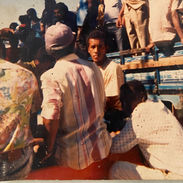
ABOUT
THE HISTORY OF OUR PEOPLE
In this menu you will find a brief account of the history of Agouti, here is described what fits in words about a story that goes beyond
Surrounded by the BA-148 highway, the community of Cutia is a place for departures and arrivals, open to meetings, as well as a bus stop. A space for passage and dwelling. Every person from Cutia welcomes – whatever visitor may arrive – with the best coffee they have at home, freshly strained, mixed with pulsating life, not too strong, so as not to frighten the unaccustomed palate, the drink comes to resemble the color of the waters of the rivers that are there. Coffee is the excuse to start the most serious conversations, such as the one I am going to start; the drink serves to bring narrator and listener closer together, in this case reader and researcher.
As a place of passage, hospitality turns out to be a community trait, a characteristic that is more pronounced there than in other nearby places, since knowing how to welcome and merge in Roots is a strategy to achieve stopping moments, as the interest is to create links, to involve multiplicities. This place where many pass and so many others stay is a rural community that remains a quilombola, which was certified by the Palmares Foundation in 2006, belonging to the municipality of Boninal in Bahia.
However, before Boninal was Boninal, at the time when that land was still called Guarany, Agouti was already there. According to official data obtained by the Coordination of Agrarian Development, the community has 258 families, but the ties and understanding by community go beyond institutional data. It should be noted that not all official information found in searches and surveys in public bodies comprises the vast complex of unofficial, non-institutionalized knowledge and understandings of Agouti.
The houses follow the sinuous curves of the river, placed side by side, with a distance that allows the neighbor to come to their aid in case of any misfortune.
Cutienses have their own division of streets, namely: Rua de Baixo and Rua de Cima, the main thoroughfares; the Corridor, the Caminho do Tanque and the Caminho do Baixão, the secondary alleys. In Agouti, there is no path that does not lead somewhere. Caminho do Tanque is the name used for the road that gives access to the Tanque, Baixão, Boi Morto, Duro terreiro and Mulungu Quilombo fields – it is a long path with community and family gardens.
The community aspect directly interferes both in the physical and architectural elements and also meanders through aspects such as how inhabitants make a living, educate their children, exchange knowledge, cultivate the land, exchange products and help each other at times of necessity.











